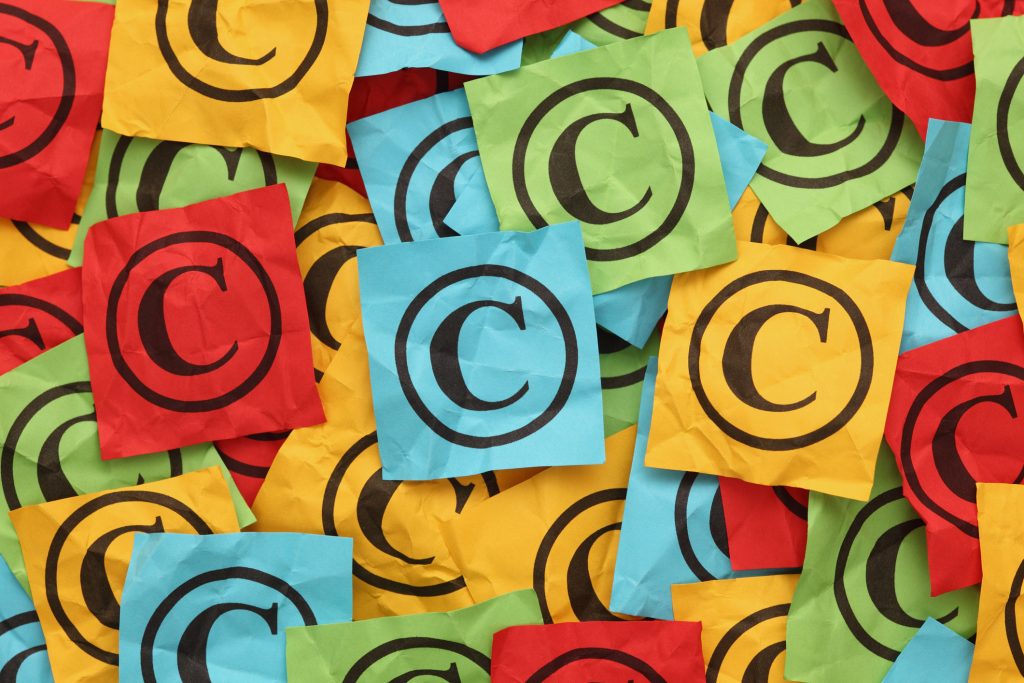CCC has licensed this analysis from Outsell, Inc. with the right to distribute it for marketing and market education purposes. CCC commissioned the research study from Outsell and had no input regarding the content of this piece. Outsell’s fact-based analysis and all aspects of our opinion were independently derived. For questions, please contact Outsell.
Methodology
In a study on behalf of Copyright Clearance Center (CCC), Outsell surveyed 584 professionals evenly split across 14 industries. Respondents were based in one of 8 countries – Austria, Germany, India, Japan, Netherlands, Switzerland, UK, and US. They worked full-time in companies with 1,000 or more employees with company revenue over $100 million. They were also from a mix of roles: 27% were executives, 47% were middle managers, and 26% were individual contributors. The research updated a series of surveys Outsell have conducted for CCC since 2003 that track what professionals think and how they behave around content and information.
Key Findings
Understanding the nature of information consumption is a core need for any provider across our industry, and this study highlights five important changes in how copyrighted content is used and shared in the work environment. Each of these has important implications for serving market needs.
Executives most aware of copyright policy, but are also the biggest compliance risk
Outsell’s research highlights a notable contradiction: executives, while having the highest awareness of their company’s copyright policies (94% compared to 66% for individual contributors), are responsible for an average of 77 instances of potential unlicensed sharing per week – over twice the 38 instances recorded for individual contributors.
Figure 1: Copyright Awareness vs. Potential Unlicensed Sharing by Organization Level
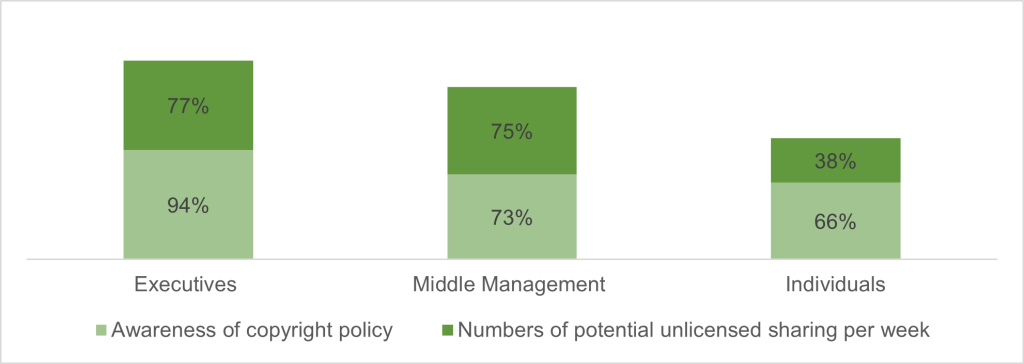
This disconnect between awareness and action represents a critical compliance challenge. Executives, by virtue of their roles, are often at the centre of information dissemination within an organisation. Their behaviour not only sets a precedent for others but also exposes the organisation to heightened legal and reputational risks. Closing this gap requires more than policy reminders; it demands targeted interventions that align executive behaviour with their awareness levels, fostering a compliance culture that starts at the top.
More communication of copyright policy doesn’t result in greater awareness
Outsell’s data challenges the assumption that frequent communication of copyright policies leads to better awareness. Surprisingly, 92% of employees who had copyright policies communicated to them only once upon hire were aware of their organisation’s copyright policy, compared to just 79% of those who had copyright policies communicated quarterly. Similarly, monthly communication achieved a high awareness rate of 89%, yet no clear correlation emerges between increased frequency and improved understanding. This suggests that simply repeating policy communication does little to enhance awareness or ensure compliance, raising questions about the efficacy of current approaches.
Figure 2: Policy Awareness by Frequency of Communicating Copyright Policy
Percentage of Respondents
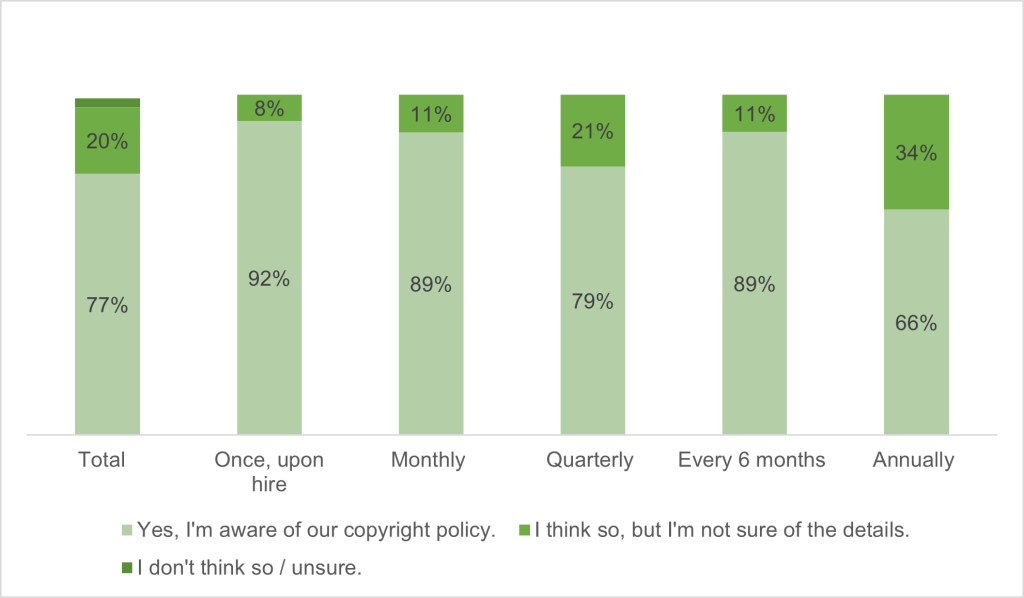
The disparity in awareness rates highlights a deeper issue: the format and delivery of copyright communication may play a more significant role than frequency alone. Communication that is passive, overly generalised, or disconnected from real-world scenarios may fail to resonate with employees, regardless of how often it is delivered. In contrast, engaging and practical formats – such as scenario-based learning or role-specific guidance – will help translate awareness into actionable compliance. For copyright owners, this insight is critical: ensuring that their intellectual property is respected requires not just policy communication but a strategic investment in how policies are conveyed.
Law firms driving AI adoption yet exposed to copyright risks
Law firms are at the forefront of AI adoption, with 97% of respondents reporting they “regularly” or “often” use AI tools. This near-universal uptake reflects the unique challenges of the legal profession, where the ability to synthesise and manage vast amounts of dense, interconnected information is critical. From detailed regulatory requirements to complex case law, AI is no longer a supplementary tool – it is becoming embedded in the fabric of legal practice, altering the role of lawyers and how services are delivered.
This transformation aligns with insights from Outsell’s April 2023 survey, which revealed that three-quarters of lawyers consider generative AI to be reliable, with 30% rating it as “extremely reliable” for providing legal information.
Figure 3: Frequency of Using AI Tools & Velocity of Content Sharing – Vertical
| Frequency of using AI tools “Often” or “Regularly” | Number potential unlicensed sharing instances per employee per week | |
| Law Firms | 97% | 192 |
| Computers & Electronic | 82% | 315 |
| Oil & Gas | 77% | 56 |
| Software & Systems | 65% | 79 |
| Consulting & Prof. Services | 61% | 87 |
| Finance / Insurance | 53% | 39 |
| Electric & Gas | 48% | 51 |
| Life Sciences | 48% | 48 |
| Chemicals & Plastics | 46% | 48 |
| Transportation & Automotive | 42% | 29 |
| Food & Beverage | 40% | 44 |
| Wholesale/ Retail | 37% | 30 |
| Hospitals & HC | 29% | 40 |
| Aerospace & Defence | 9% | 55 |
| TOTAL | 52% | 66 |
For a profession that has remained largely unchanged for centuries, generative AI is ushering in profound transformation for the legal services industry. Unlike previous technologies, which simply sped up manual tasks, generative AI enables firms to distil insights from enormous volumes of legal data and streamline highly specific processes like contract drafting or due diligence reviews. Lawyers are moving away from spending their time on labour-intensive tasks like combing through documents to focusing on more strategic and creative elements of their work. This shift is fundamentally redefining what it means to practice law in 2025.
However, when it comes to copyright compliance, law firms rank as the second highest industry at risk of potential unlicensed sharing, with 192 violations per employee per week—nearly triple the average of 66 violations per employee per week. For firms that counsel clients on intellectual property and compliance, this exposes a reputational vulnerability that demands urgent action. Only the Computers and Electronics sector exceeds this, with 315 violations per employee per week, highlighting a significant compliance challenge in both industries.
Lower awareness of copyright policy in AI use is a growing risk
Despite AI tools rapidly transforming how organisations work, awareness of copyright policies related to AI use lags behind general copyright awareness. According to Outsell’s findings, only 62% of respondents are aware of their organisation’s copyright policy as it applies to AI tools, compared to 77% for general copyright policies. This gap suggests that while organisations are integrating AI into workflows, they are not adequately preparing employees to manage the compliance risks associated with these tools. Without clear guidance, employees may unknowingly misuse third-party content in AI workflows, exposing organisations to copyright compliance risks.
Figure 4: General Copyright Policy Awareness vs. AI Copyright Policy Awareness
Percentage of Respondents
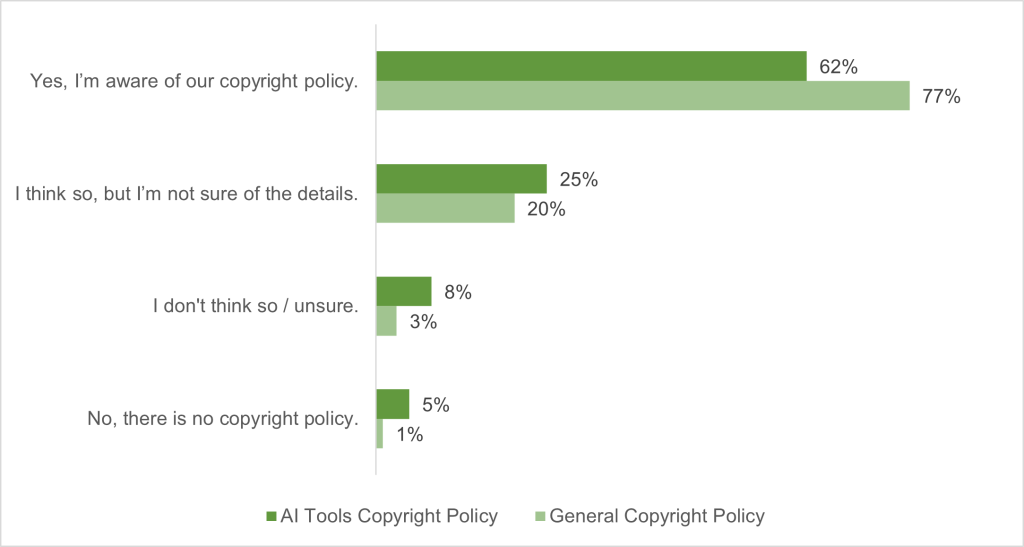
The risks are particularly acute when employees use third-party published information with AI tools without obtaining the necessary permissions. AI tools often require large datasets for analysis, synthesis, or training, increasing the likelihood of copyright infringement. For example, feeding protected text into generative AI models or using AI to repurpose published materials for external use can lead to unintended violations. Building awareness of copyright compliance in the context of AI is critical. Organisations must prioritise training programs and licensing that address the intersection of AI and copyright, providing employees with practical guidelines for using AI tools responsibly.
Collaboration tools gaining ground over email
While email remains the most commonly used method for sharing work-related information (81% of respondents), collaboration tools are quickly emerging as the preferred choice. In 2022, email was the top preferred method for sharing work-related information at 41%, but by 2024, it had fallen to second place at 34%. Meanwhile, collaboration tools have creeped ahead, growing from 33% preference in 2022 to 38% in 2024. This shift underscores a growing trend: employees are gravitating toward platforms that facilitate seamless communication and enable real-time collaboration, signalling a move away from the static nature of email attachments.
Figure 5: Preferred Method of Sharing Work-Related Information – Trend
Percentage of Respondents
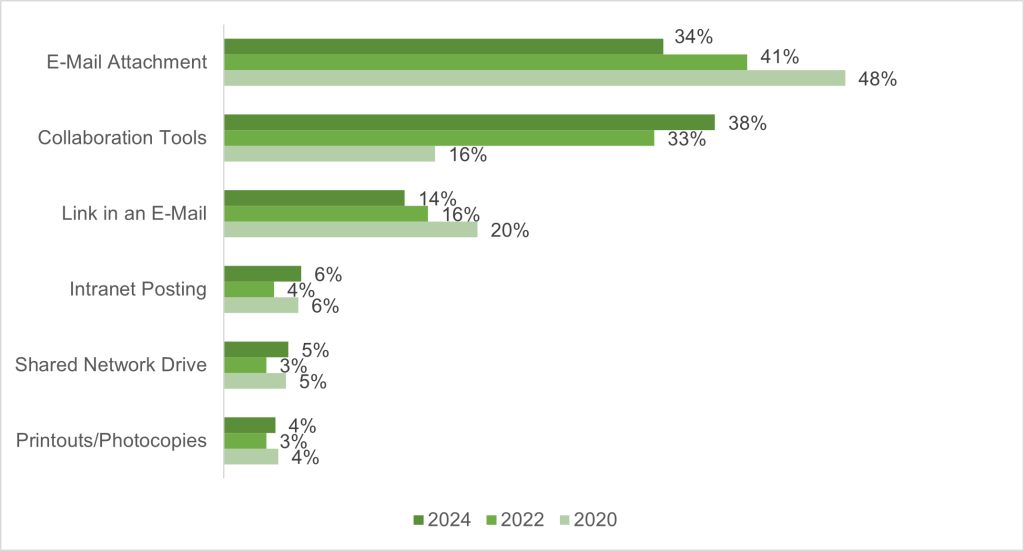
This change has significant implications for information providers and copyright owners. With collaboration platforms, sharing is integrated into workflows, encouraging broader dissemination and use of information. As a result, employees are sharing with a greater number of colleagues more frequently, which means that the lifecycle of proprietary content is extending beyond its original scope. This increased sharing creates both opportunities for wider content usage and risks of copyright breaches if licensing and permissions are not managed effectively.
Copyright owners, need to ensure their content is accessible and usable within collaboration tools in ways that respect copyright and licensing agreements. The rise of collaboration platforms also underlines the critical need for companies and organisations to subscribe to collective copyright licensing. Such agreements provide a structured framework for widespread, compliant sharing of third-party content within modern workflows.
Implications
The evolving dynamics of information sharing and usage present complex challenges for information providers, publishers, and copyright owners. The gap between copyright awareness and compliance, especially among executives, points to deeper systemic issues in how organisations manage intellectual property in high-pressure environments. Executives are pivotal as conduits for large-scale dissemination of content and their missteps in copyright compliance carry heightened risks.
The shift toward collaboration platforms as the preferred sharing method signifies a broader change in workplace communication. These tools, with their integration across workflows, enable unprecedented connectivity but also complicate compliance. While transactional records exist, their real-time nature and ease of use create an environment where content can move across organisational boundaries more fluidly, often without deliberate checks on permissions or licensing terms. This trend expands the reach of content but raises the stakes for ensuring compliance mechanisms are embedded in these platforms.
AI-driven workflows amplify these challenges further. As AI tools depend heavily on large datasets for tasks like content generation, the risk of copyright compliance increases substantially. Copyright owners need to safeguard intellectual property rights without stifling the adoption of transformative technologies. The convergence of collaboration, AI, and information sharing calls for a more advanced approach to licensing and compliance. Providers that streamline content access while integrating tools and clear terms for license adherence are well-positioned to drive stronger adoption and long-term engagement with customers and end-users.
Essential Actions
As AI becomes embedded in every professional’s workflow, copyright compliance will grow increasingly complex. This shift, coupled with the transformative rise of collaboration tools, is reshaping how content is created, shared, and consumed within organisations. In this evolving landscape, it is critical for senior executives to not only be aware of copyright compliance but to actively lead by example, ensuring their actions align with the policies they advocate. To navigate these challenges effectively, information providers, publishers, and copyright owners must take the following steps:
Develop Role-Specific Copyright Compliance Strategies
The disconnect between awareness and compliance, particularly among executives, highlights the need for tailored compliance strategies. Copyright owners and publishers must create role-specific training and enforcement mechanisms that address the unique responsibilities and risks of different organisational levels. For executives, this includes decision-making simulations or tools that emphasise the legal and reputational consequences of unlicensed sharing. For middle managers and individual contributors, targeted interventions can focus on everyday scenarios, ensuring policies are actionable and relevant across all roles.
Embed Licensing and Compliance into Collaboration Platforms
The rapid rise of collaboration tools as a preferred sharing method underscores the need for seamless integration of copyright compliance within these platforms. Copyright owners must work closely with collaboration tool providers to embed licensing mechanisms, automated permissions, and usage tracking into the workflows of these tools. This will allow organisations to align employee behaviour with compliance policies without disrupting productivity, ensuring content is shared responsibly within a structured framework.
Create AI Licensing Models
The reliance on AI tools for workflows like generative content creation and predictive analytics demands a rethinking of traditional licensing approaches. Copyright owners can invest in licensing models and machine-readable content formats designed specifically for AI use cases, such as subscription-based frameworks for large-scale data usage. Additionally, creating AI-specific compliance guidelines can help mitigate the risks of inadvertent copyright breaches.
Encourage Adoption of Collective Licensing Agreements
As content sharing becomes more integrated into workflows, collective licensing agreements will play a pivotal role in managing copyright compliance. Copyright owners can advocate for collective licensing by demonstrating how these frameworks reduce complexity, minimise risks, and create predictable cost structures for organisations.
Create Format-Rich Resources for Copyright Compliance
Copyright owners must move beyond passive communication and develop interactive, scenario-based resources tailored to real-world applications. Using videos, infographics, and role-specific guides, these materials ought to align with employee workflows to make compliance practical and actionable. By fostering deeper understanding through engaging formats, copyright owners can help businesses integrate copyright policies into daily operations, reducing the risk of unlicensed sharing.
Copyright 2025 Outsell, Inc www.outsellinc.com/contact
For a full breakdown of 2025 Copyrighted Content Usage trends, visit the Information Seeking & Usage Study resources here.

